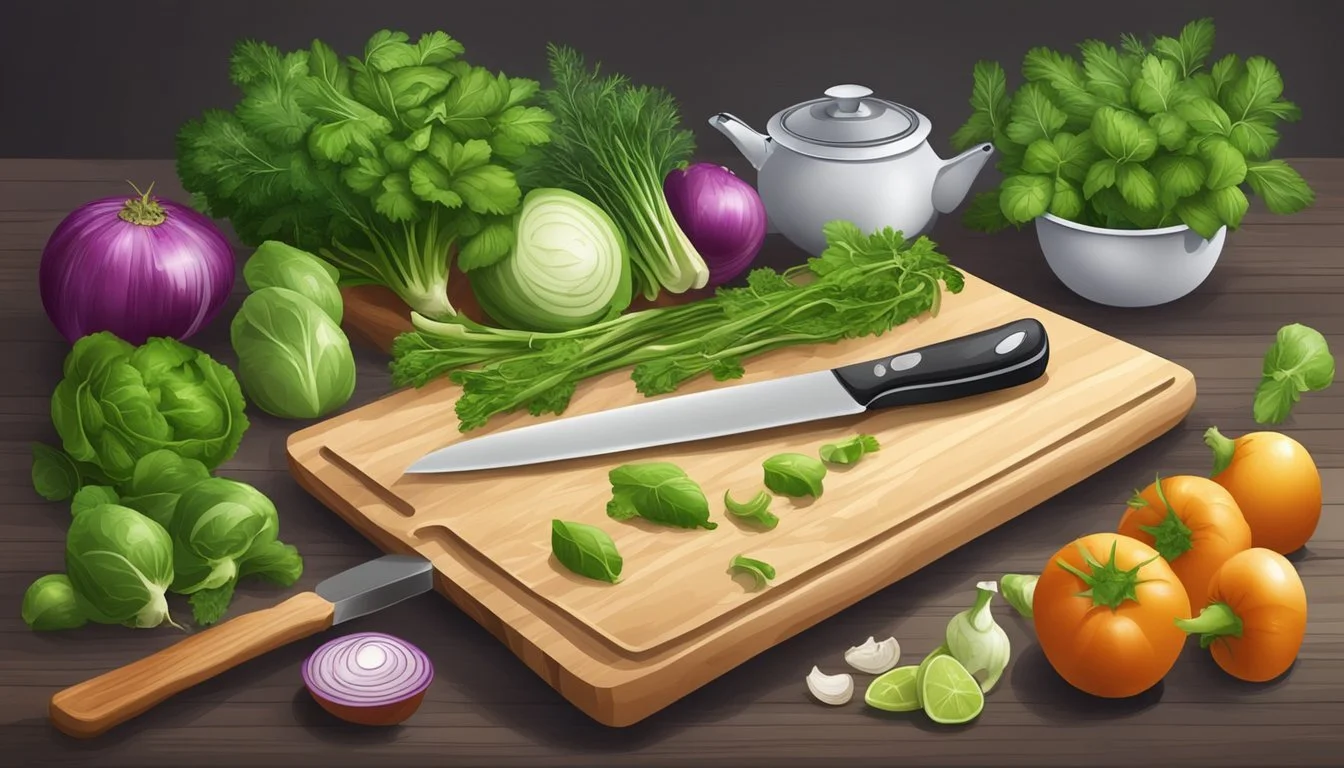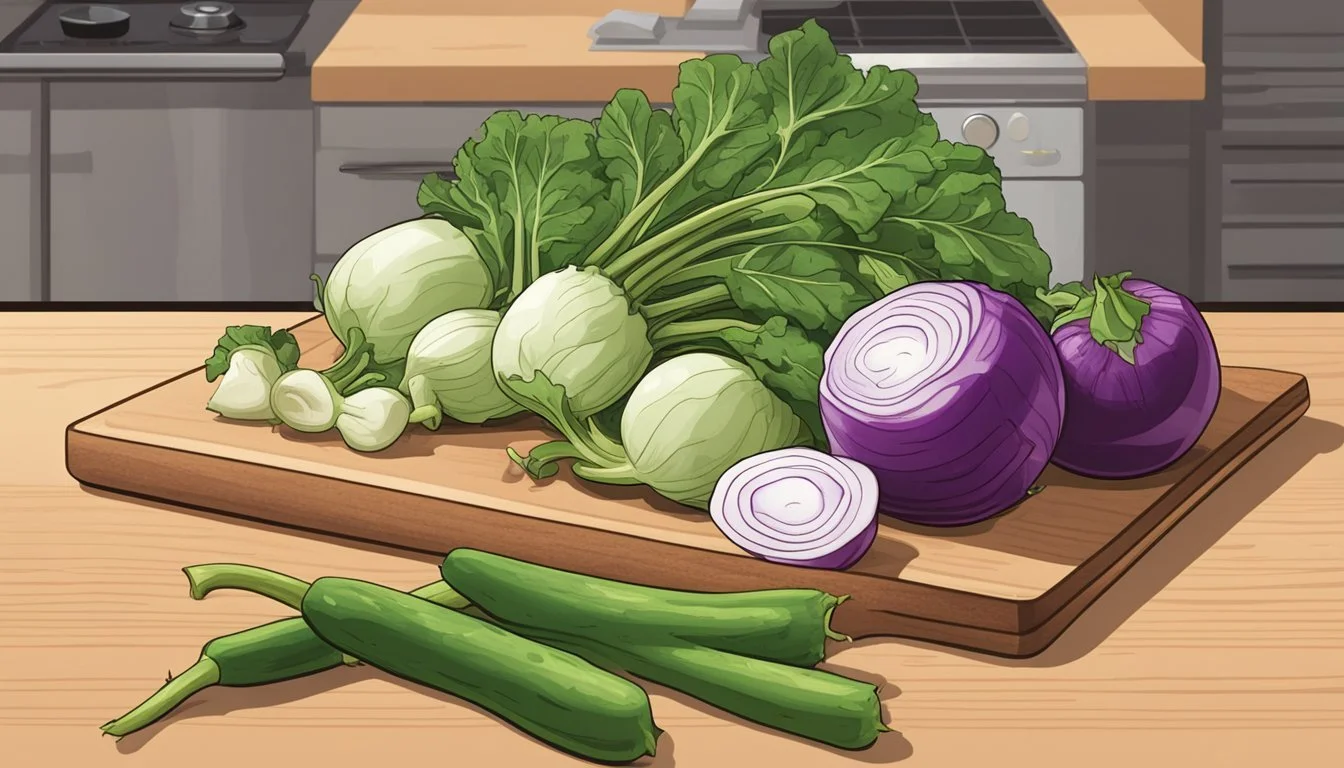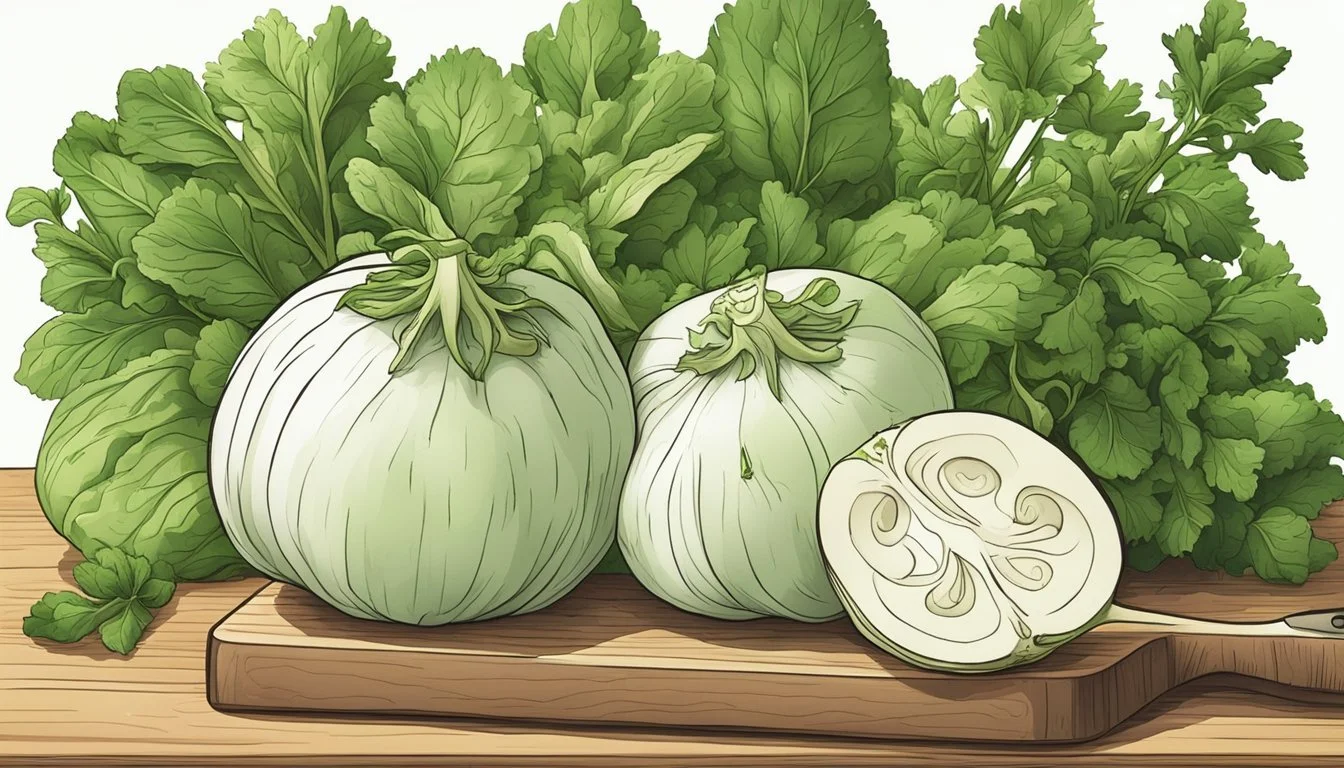How to Cook with Kohlrabi for a Turnip-Like Twist
Mastering Unique Veggie Flavors
Kohlrabi, often likened to a turnip, has gradually carved out a niche in the culinary world, known for its versatility and health benefits. This stout, round vegetable comes in two hues: green and purple, each encased in a tough exterior that gives way to a crisp, slightly sweet flesh reminiscent of broccoli stems. Championed by nutritionists for its high content of vitamin C, dietary fiber, potassium, and antioxidants, kohlrabi presents itself as a nutritious addition to any meal, promising not just taste but also a boost to one's overall health.
Cooking with kohlrabi can introduce an innovative twist to traditional dishes, providing a crunchy and flavorsome counterpart to the more familiar textures and flavors we expect from root vegetables. Its ability to absorb a range of flavors makes it a fitting candidate for various cooking methods, from roasting and sautéing to steaming and even eating raw. The leaves of kohlrabi, akin to collard greens, can also be utilized for their tenderness and nutrient-rich profile, ensuring that no part of this versatile vegetable goes to waste.
Designed for both the novice and the adept kitchen enthusiast, kohlrabi's approachability is evident in its simple preparation. Whether one opts to slice it for a stir-fry, dice it for a hearty stew, or cut it into sticks for a nutritious snack, this unassuming vegetable stands ready to elevate everyday cooking with its unique character and nutritional benefits. As the culinary community continues to explore and embrace lesser-known produce, kohlrabi secures its spot as a dynamic and enriching addition to the modern kitchen repertoire.
Getting to Know Kohlrabi
Kohlrabi, often found nestled among the leafy greens and root vegetables at the grocery store, surprises many with its turnip-like appearance and sweet, mild flavor. It comes in both green and purple varieties, adding a vibrant and nutritious twist to dishes.
Origins and Varieties
Kohlrabi, belonging to the Brassica oleracea family, is a cousin of cabbage, broccoli, and kale. It's primarily grown in Europe, with Germany being a significant producer, leading to its moniker "German turnip." Though lesser-known than its cruciferous relatives, kohlrabi has been a staple in German cuisine (What Wine Pairs Perfectly With German Cuisine) for centuries. It comes in two main color varieties:
Green Kohlrabi: This is the more common type, typically found in grocery stores.
Purple Kohlrabi: Less common, it makes an appealing visual addition to dishes with its vibrant hue.
Health Benefits and Nutrition
Kohlrabi is rich in nutrients, providing a medley of vitamins and minerals beneficial for health:
Vitamins: It contains vitamin C, which supports immune function, and B-vitamins, important for energy production.
Minerals: Kohlrabi is a source of calcium, crucial for bone health, and potassium, which helps regulate blood pressure.
Kohlrabi's nutrition profile positions it as a valuable addition to a healthy diet:
Nutrient Benefit Vitamin C Antioxidant support B-vitamins Supports metabolism Calcium Strengthens bones Potassium Maintains normal blood pressure
Selecting the Best Kohlrabi
When selecting kohlrabi at the grocery store, shoppers should look for bulbs that are firm and free from blemishes or cracks. Size is also an indicator of quality; smaller bulbs tend to have a sweeter, more tender texture compared to larger, potentially woodier bulbs. Leaves, if attached, should appear fresh and vibrant, suggesting the kohlrabi's freshness.
Preparation Essentials
Properly preparing kohlrabi ensures it retains its crisp texture and sweet, turnip-like flavor. Key steps include thorough cleaning, appropriate cutting techniques, and careful peeling.
Cleaning and Storing
To begin with, one must clean kohlrabi effectively to remove any dirt or debris. The bulb should be rinsed under cool, running water, and any remaining dirt can be gently scrubbed off with a brush. For the leaves, a more delicate wash in a bowl of water may be necessary to preserve their integrity. Once cleaned, kohlrabi can be stored in the refrigerator to keep it fresh. If one plans to use it within a few days, storing it in a loose plastic bag in the crisper drawer works well.
Cutting Techniques
Cutting kohlrabi requires a sharp knife and an understanding of the desired end use. For dishes requiring longer cooking times, cutting the bulb into wedges or chunks is appropriate. In contrast, for quick cooking or raw preparations, one should slice the kohlrabi into thin strips or sticks. A consistent cut allows for even cooking and texture. The tender leaves can be separated from the stems, chopped if necessary, and added to dishes similarly to how one would use spinach.
Peeling and Trimming
Before one proceeds with cooking, peeling the outer layer of the kohlrabi bulb is crucial as it can be tough and fibrous. Using a vegetable peeler, peel off the skin until one reaches the light-colored, crisp flesh. For kohlrabi that will be boiled or roasted, this works best after cutting it into the desired shape. Trimming is also a necessary step; one should remove the stems before cooking, as these can be woody, with the exception of the tender young stems that can be finely sliced and cooked.
Cooking Methods
Kohlrabi, often compared to a turnip, offers a variety of preparation methods that can transform its taste and texture. Chefs and home cooks alike appreciate kohlrabi for its versatility in the kitchen, whether aiming for tender perfection or a crisp bite.
Boiling and Steaming
Boiling kohlrabi can simplify the process of achieving a tender texture. To boil, simply submerge peeled slices or cubes in water and cook for 20 to 30 minutes. For a healthier method retaining more nutrients, steaming is ideal. Chopped kohlrabi can be steamed until it's perfectly tender, typically taking less time than boiling—around 5 to 10 minutes.
Roasting and Baking
Roasting transforms kohlrabi's flavor, giving it a delightful, crisp exterior and a tender center. Preheat the oven to 425 degrees F, toss peeled kohlrabi pieces with olive oil and seasonings such as garlic powder, salt, and pepper. Spread them on a baking sheet and roast until golden—around 25 to 30 minutes. Baking, especially in recipes like scalloped kohlrabi, involves a heated oven and a suitable dish to create a bubbly, browned surface and a creamy interior.
Sautéing and Grilling
For a quick and flavorful side, sautéing kohlrabi is an excellent choice. In a skillet, cook thin slices with a bit of butter or oil until they start to caramelize, becoming slightly al dente. Grilling imparts a smoky flavor and char to the kohlrabi, making it a standout at barbecues. Brush with oil and grill over medium heat until marked and crisp-tender.
Versatile Recipes
Kohlrabi, with its turnip-like flavor and texture, can be transformed through a variety of cooking methods. It lends itself well to crisp salads, comforting stews, and innovative side dishes. Below, find some specific ways to incorporate kohlrabi into meals.
Kohlrabi Salads and Slaws
Raw Kohlrabi Salad: Thinly slice kohlrabi and mix with apples, carrots, and a vinaigrette dressing for a crisp and tangy taste.
Asian-Inspired Slaw: Combine julienned kohlrabi with cabbage and carrots, dressed in a soy, ginger, and miso dressing for an umami flavor.
Hearty Kohlrabi Stews and Soups
Creamy Kohlrabi Soup: Purée cooked kohlrabi into a creamy broth, seasoning with herbs for a comforting bowl.
Kohlrabi Vegetable Stew: They can chop kohlrabi and add it to a robust stew with tomatoes, beans, and aromatic vegetables, simmering until tender.
Creative Kohlrabi Sides
Roasted Kohlrabi: Cut into wedges, drizzle with olive oil, season with sea salt, and roast until caramelized.
Kohlrabi Fries: Toss sticks of kohlrabi with garlic powder, paprika, and cumin, then bake or air-fry for a savory side dish.
Innovative Serving Suggestions
Kohlrabi is a versatile vegetable that offers a healthy, crunchy twist to many traditional dishes. This section explores novel ways to incorporate kohlrabi into meals.
Kohlrabi Alternatives to Traditional Dishes
Kohlrabi can be a refreshing alternative in recipes that usually feature potatoes, apples, or radishes. It lends a similar crunch and a mild, peppery flavor that enhances the dish:
Kohlrabi Fries: Cut kohlrabi into sticks, season, and bake or air-fry as a lower-carb alternative to traditional potato fries.
Apple & Kohlrabi Slaw: Combine grated kohlrabi with apple slices for a crunchy and smooth slaw that pairs wonderfully with barbecue dishes.
Pairing with Proteins and Vegetables
One can pair kohlrabi seamlessly with a variety of proteins and vegetables for a complete, nutritious meal:
Egg Dishes: Add diced kohlrabi to omelets or frittatas, combining with spinach or carrots for extra texture and flavor.
Meat Companions: Serve roasted or steamed kohlrabi as a side to grilled or roasted meats (What wine goes well with roasted meats?). Its subtle taste complements beef, pork, and chicken.
Raw Kohlrabi Snacks and Appetizers
Raw kohlrabi is crisp and delicious, making it perfect for snacks and appetizers:
Crudités: Slice kohlrabi into thin sticks and serve with hummus or dip for a healthy, raw appetizer.
Kohlrabi Chips: Thinly slice kohlrabi and dehydrate or bake until crispy for a crunchy snack alternative.
Tips for Perfect Kohlrabi Dishes
To elevate kohlrabi from a simple root vegetable to a delicious component of any meal, one must pay attention to texture and flavor nuances, and understand how to complement dishes with this unique vegetable.
Mastering Texture and Flavor Balances
Achieving the right texture for kohlrabi is essential; it should be tender but still offer a slight crispness. Overcooking can lead to a mushy consistency, while undercooking might leave an undesirably tough texture. One begins by peeling the fibrous outer layer of the kohlrabi bulb before cooking.
Boiling: Slice or cube kohlrabi and boil until tender but firm (approximately 15-20 minutes), then enhance with a pinch of salt and a pat of butter.
Roasting: Cut kohlrabi into even pieces, drizzle with olive oil, season with salt, pepper, and garlic powder, and roast at a high temperature until the edges start to caramelize.
Air Frying: Kohlrabi fries benefit from a high-temp cook for a crispy exterior. A seasoning blend of garlic powder, smoked paprika, and cumin adds depth.
To balance kohlrabi's flavor, which can range from sweet to mildly spicy, proper seasoning is key. Start with classic salt and pepper, and consider complementing sweetness with a touch of sugar or honey, especially when caramelizing during roasting or sautéing.
Enhancing Dishes with Kohlrabi
Kohlrabi's versatility allows it to shine across various dishes. Its texture complements both creamy and crunchy components, while its flavor can stand up to bold seasonings.
Raw: Thinly sliced kohlrabi adds a fresh, crunchy element to salads. Season with salt to wilt slightly and release moisture.
Creamed: For a richer dish, cook kohlrabi until soft and blend into a purée with cream or incorporate into a white sauce, balancing with pepper and a hint of nutmeg.
With Greens: The leaves of kohlrabi, resembling those of turnips, can be cooked like spinach. Sauté the leaves briefly in olive oil until they just begin to wilt for a nutritious side.
Introducing kohlrabi into one's culinary repertoire can offer a turnip-like twist to the palate, whether they seek to enhance a raw salad with its crispness or a warm dish with its sweetly nuanced flavor.
Preservation and Longevity
When dealing with kohlrabi, both the bulb and the greens are edible parts of this root vegetable, akin to a turnip or jicama in form and texture. To preserve kohlrabi, one should begin by separating the leaves from the bulb. The greens can be stored in the same manner as other leafy vegetables.
Storing the Greens:
In the refrigerator: Place the greens in a plastic bag after trimming any heavy stems. They should be kept damp but not wet; a paper towel added to the bag helps absorb excess moisture.
Usage timeframe: It’s best to use the kohlrabi greens within a few days to ensure freshness and maintain nutritional value.
Storing the Bulb:
Without refrigeration: For short-term storage, a cool, dark place can preserve the kohlrabi bulb for a few days.
In the refrigerator:
Wrap the bulb in a damp paper towel and place it inside a perforated plastic bag.
The crisper drawer is an ideal spot, offering a balance of humidity and air circulation.
Shelf life: Kohlrabi bulbs can last up to several weeks under proper refrigeration.
For optimal longevity, it's crucial that the bulbs are not washed until just before usage to prevent premature spoilage. Furthermore, one should ensure that their refrigerator is at the correct temperature setting, typically around 32-40°F (0-4°C), to prolong the lifespan of this root vegetable. If a kohlrabi bulb feels soft or shows signs of wrinkling, it’s an indication that it should be used promptly to enjoy its full flavor and texture.





